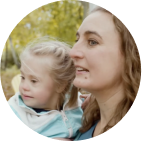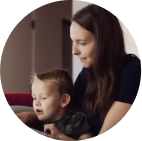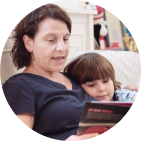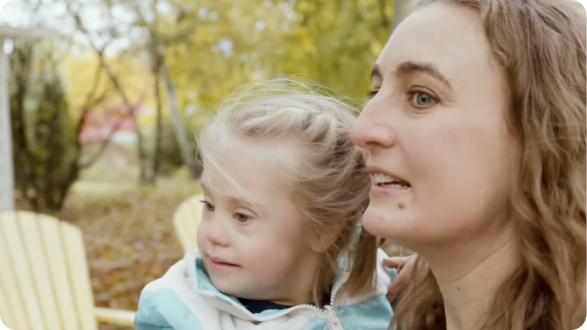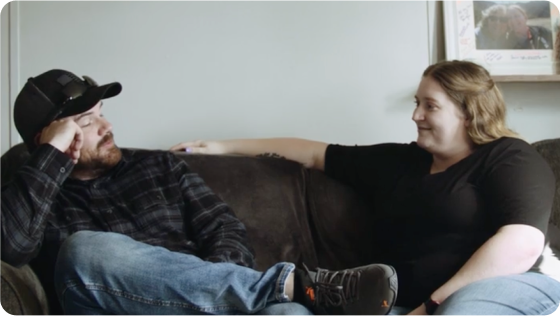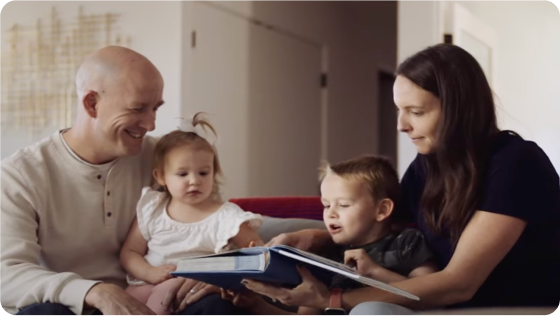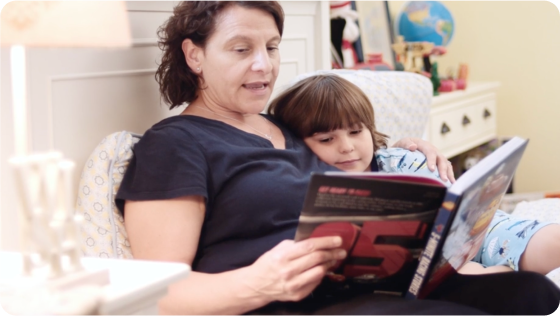

Hear the personal stories
See how screening helped four different families learn more about their genetic health and do what they felt was best for their babies.
How parents used genetic screening results to help guide their pregnancies
For most parents, screening results provide peace of mind, because only a low risk of a serious genetic condition has been detected. For others, high risk results can quickly lead to valuable actions.
A 10-week screen turns hope into a plan
As soon as Hannah’s cell-free DNA screening results showed that her daughter had an increased risk of having Down syndrome, the preparation began.
She and her husband met with a developmental pediatrician and a cardiologist. She connected with other moms via the Down Syndrome Diagnostic Network and found an appropriately equipped delivery facility. “Life now is great. Juliana loves music and she loves dogs, and she loves playing outside.”
Hannah becomes pregnant with Juliana.
Hannah becomes pregnant with Juliana.
Hannah opts for a Prequel® Prenatal Screen when she is 10-weeks pregnant. The screen shows that Juliana has an increased chance of having Down syndrome.*
Hannah opts for a Prequel® Prenatal Screen when she is 10-weeks pregnant. The screen shows that Juliana has an increased chance of having Down syndrome.*
Hannah and her partner make a plan for Juliana’s arrival.
Hannah and her partner make a plan for Juliana’s arrival.
They meet with a developmental pediatrician.
They meet with a developmental pediatrician.
They meet with a cardiologist and get an ultrasound of her heart.
They meet with a cardiologist and get an ultrasound of her heart.
They connect with the Down Syndrome Diagnosis Network to build community.
They connect with the Down Syndrome Diagnosis Network to build community.
Juliana is born with Down syndrome, has a team and community in place, and is thriving.
Juliana is born with Down syndrome, has a team and community in place, and is thriving.
* Hannah and her partner chose to forgo diagnostic testing.
Relief for a concerned mom
After three miscarriages, Naomi was hesitant to try prenatal screening. But her doctor convinced her to make sure she got the care she needed to bring her healthy baby home.
A simple blood draw revealed low risk for a serious genetic condition. “Getting those results was a huge relief, especially as a mom with previous losses.”
There was hesitation in having answers. But there was more hesitation in not having answers.
- Naomi
Carrier screening helped both of Ashley’s children
When Ashley’s son Christopher began to show symptoms after he was born, she became aware of how the Foresight® Carrier Screen could help them get a diagnosis and treatment faster.
The outcomes were totally different for her second child. “We had the carrier screening done, so we could make a plan. Because of that, she’s living a typical life.”
Ashley is 26, pregnant, and experiencing a complication-free pregnancy.
Ashley is 26, pregnant, and experiencing a complication-free pregnancy.
Ashley delivers Christopher.
Ashley delivers Christopher.
At around 18 months, Christopher has not yet started walking.
At around 18 months, Christopher has not yet started walking.
Ashley and her husband learn about the Foresight Carrier Screen, get tested, find they are both carriers of spinal muscular atrophy (SMA), and that Christopher is affected.
Ashley and her husband learn about the Foresight Carrier Screen, get tested, find they are both carriers of spinal muscular atrophy (SMA), and that Christopher is affected.
Christopher gets medical interventions and extensive physical therapy, and eventually learns to walk with braces.
Christopher gets medical interventions and extensive physical therapy, and eventually learns to walk with braces.
Ashley is pregnant again with Emily. Because they know they are SMA carriers and there is a 25 percent chance Emily could be affected, they have an early intervention plan.
Ashley is pregnant again with Emily. Because they know they are SMA carriers and there is a 25 percent chance Emily could be affected, they have an early intervention plan.
Emily is delivered and is positive for SMA. The early therapeutic interventions mean that Emily hits her milestones and is still showing no symptoms of SMA.
Emily is delivered and is positive for SMA. The early therapeutic interventions mean that Emily hits her milestones and is still showing no symptoms of SMA.
Identifying a life-threatening disorder with carrier screening
Less than a week after she was sent home with her son, Michele knew that something was different. Her pediatrician told her that her son might have a rare genetic disorder called congenital adrenal hyperplasia.
Carrier screening revealed that both Michele and her husband were carriers. The results, and her doctor’s quick thinking, were life-saving, even though the underlying condition can’t be altered. “I would tell every individual thinking of having a child that having a carrier screen is vital.”
The more information you have, the better prepared you will be for what may lie ahead.
- Michele

